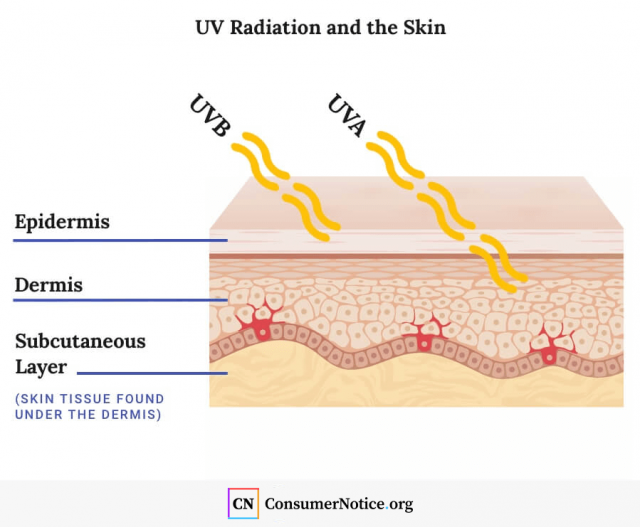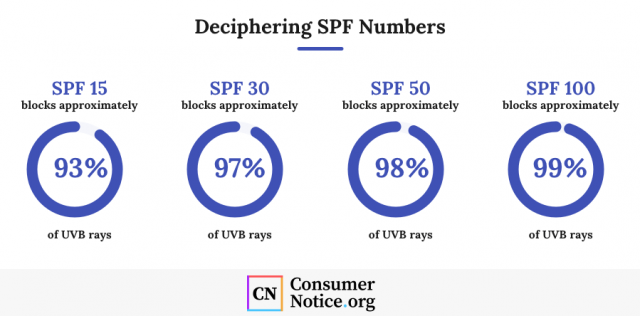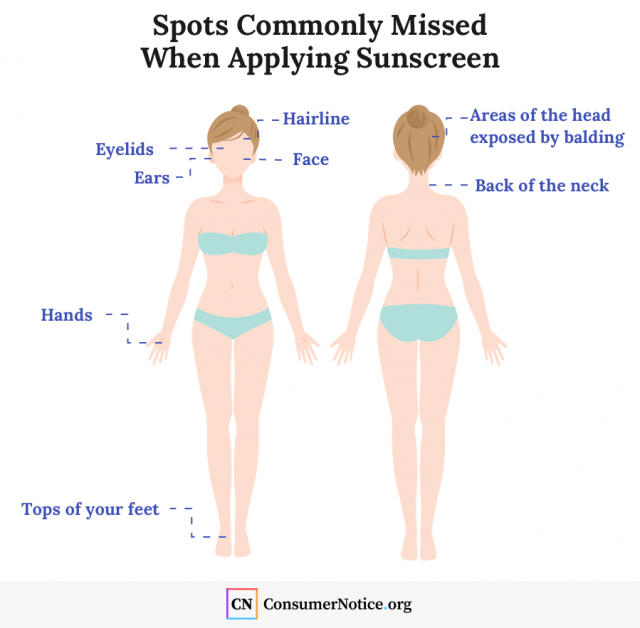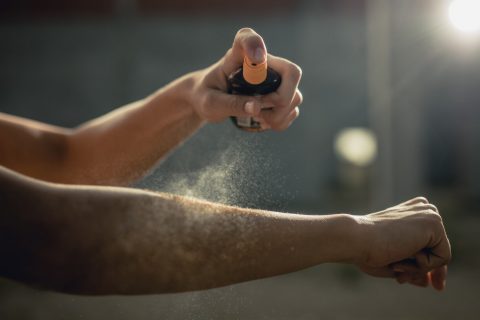Consumer Guide to Sunscreen: Risks & Benefits
Despite claims casting a shadow over sunscreen’s safety and effectiveness, experts say consumers should be more concerned about the risk of skin cancer. Still, it’s important to understand the ingredients, terminology, risks and benefits that come with each sunscreen bottle you pick up in the store and how to best protect your skin.
Skin cancer is the most common form of cancer in the United States. It’s estimated that one in five Americans will be diagnosed with skin cancer at some point in their lifetime. Many people rely on sunscreen to reduce these risks and prevent premature aging.
But recent studies and reports claim that many of the sunscreen products sold in stores don’t work as well as they claim, and certain chemical ingredients in some products may not be safe. Another controversy involves the claim that using sunscreen will lead to low vitamin D levels.
As the Food and Drug Administration looks to update its regulatory requirements for most sunscreen products, Consumer Notice took a hard look at the controversies to see if the science backs up the scary hype.
Our conclusion: Sunscreen is still an important and effective tool to reduce your skin cancer risk, but choosing the right sunscreen and knowing how to properly use it is also key.
How Does Sunscreen Work?
To understand how sunscreen works, it helps to understand how the sun’s rays affect us. The sun emits ultraviolet radiation in several different wavelengths that is invisible to the naked eye but damaging to the skin.
UVC rays are the shortest wavelengths of light, but they are also the most damaging. Fortunately, few of them make it through the earth’s atmosphere and most are absorbed by the ozone layer.
UVB rays are longer than UVC rays, and they do make it through the atmosphere. UVB rays penetrate the superficial layers of the skin, causing reddening and sunburn. UVB rays are the most common cause of skin cancer.
UVA rays are less intense than UVB rays but much more prevalent. They penetrate the skin more deeply and play a major role in premature aging. UVA rays are also believed to play a role in initiating the development of skin cancer.

Sunscreen works by blocking and absorbing these harmful rays so they can’t damage your cells.
There are two types of sunscreens: physical sunscreen and chemical sunscreen. Understanding the difference between the two types can help you choose the one that’s best for you.
Physical sunscreen contains active minerals that sit atop your skin’s surface and deflect and scatter damaging ultraviolet rays. Titanium dioxide and zinc oxide are common ingredients in physical sunscreen, or physical blockers, as they’re sometimes called.
Physical sunscreens can be difficult to rub into your skin and sometimes leave a white residue on the skin, though newer physical sunscreens use small particles, or nanoparticles, that are less likely to leave streaks. They also tend to be tolerated better by people with sensitive skin.
Chemical sunscreens, on the other hand, create an extra barrier on the surface of the skin to absorb the sun’s UV rays like a sponge. Common active ingredients in chemical sunscreens sold in the United States include: avobenzone, ensulizole, homosalate, octinoxate, octocrylene or oxybenzone. They are easier to rub into your skin than mineral sunscreens and less likely to leave a visible residue.
Some products contain both physical and chemical ingredients.
Is It Safe?
In recent years, some health groups, consumer organizations and others have raised concerns about how the chemical ingredients in many sunscreens may affect people’s health. Recent actions and studies by the FDA have added to the controversy and confusion.
In May 2019, the non-profit Environmental Working Group issued its 13th annual guide to sunscreens. The EWG’s 2019 study reviewed more than 1,300 sunscreen products and concluded that two-thirds offer inadequate sun protection or contain worrisome ingredients, such as oxybenzone.
The EWG report came just days after an FDA study published in May 2019 in JAMA found that four chemicals commonly used in sunscreen are rapidly absorbed into people’s bloodstreams. All four chemicals — avobenzone, oxybenzone, octocrylene and ecamsule — exceeded maximum blood concentration limits set by the FDA within one day of being applied.
What this all means, however, is unclear.
The researchers said the clinical significance of this sort of systemic exposure is unknown and should be studied further but advised consumers to continue using sunscreen in the meantime. And dermatologists that Consumer Notice spoke with agreed.

Dr. Joshua Zeichner, the director of Cosmetic & Clinical Research in Dermatology at Mount Sinai Hospital in New York, told Consumer Notice that many questions remain.
He noted that in an FDA study, large amounts of sunscreen were applied to three-quarters of the study subjects’ bodies. But in the real world, Zeichner said, consumers don’t use that much sunscreen and they don’t usually reapply it religiously every two hours. So it’s unclear how much absorption would occur under normal patterns of usage.
Aside from that, Zeichner said sunscreen’s protective benefits outweigh any potential risks.
“We have not seen any harmful health effects of sunscreen with years of application on millions of people,” he said.
Johnson & Johnson Sunscreen Recall
On July 14, 2021, Johnson & Johnson issued a voluntary recall for some of its Neutrogena and Aveeno spray sunscreens after lab testing found low levels of benzene in some samples. The company told consumers to stop using the products immediately and dispose of them properly.
Benzene is a chemical used to make pesticides, rubber, plastics and other products. The World Health Organization and U.S. Department of Health and Human Services have said that benzene can cause cancer, specifically leukemia. Benzene isn’t normally an ingredient found in sunscreen, and J&J is investigating how it got into the recalled products.
Products affected by the recall include:
- Aveeno Protect + Refresh aerosol sunscreen
- Neutrogena Invisible Daily defense aerosol sunscreen
- Neutrogena Beach Defense aerosol sunscreen
- Neutrogena Cool Dry Sport aerosol sunscreen
- Neutrogena Ultra Sheer aerosol sunscreen
According to J&J’s recall statement, the amounts of benzene found in its products shouldn’t cause health problems. But lawyers are already investigating potential sunscreen lawsuits.
Banana Boat Spray-On Sunscreen Recall
Edgewell Personal Care Company added to a recall of its Banana Boat Hair & Scalp Sunscreen Spray SPF 30 in January 2023. The expanded recall included a new batch lot affected by benzene contamination. The original recall was issued in 2022.
An internal review by the company found the source of the benzene was a propellant that sprays the sunscreen out of the can. Edgewell said it does not use benzene in any of its products.
The company offers reimbursement to anyone who purchased sunscreen with the affected lot codes. Consumers may call 1-888-686-3988 for a refund.
- 20016AF
- 20084BF
- 21139AF
- 20301CF
Consumers may locate lot codes on the bottom of the can.
Ingredients in Sunscreen
Currently, only two common ingredients in sunscreen — titanium dioxide and zinc oxide — are designated as “generally recognized as safe and effective,” or GRASE, by the FDA. Both minerals are physical sunscreens that sit on top of the skin.
Two other ingredients — PABA and trolamine salicylate — are not GRASE and are considered unsafe for use. But consumers have little reason to worry here because both chemicals are no longer available in the United States.
But not enough is known about a dozen other sunscreen ingredients to determine whether they are safe. They include commonly used chemicals, such as avobenzene, homosalate, octinoxate, octisalate, octocrylene and oxybenzone, and less commonly used ingredients, such as cinoxate, dioxybnezone, ensulizole, meradimate, padimate o and sulisobenzone.
Oxybenzone Controversy
Of all those chemicals, oxybenzone has grabbed the most attention. Oxybenzone, which is present in about two-thirds of non-mineral sunscreens, is known to cause allergic reactions. In animal studies, the chemical has been linked to hormonal disruptions, including toxicity to the male reproductive system.
Its effects on humans are unclear, but oxybenzone is absorbed through the skin and has been found in breast milk, amniotic fluid, urine and blood. A 2008 study by researchers at the Centers for Disease Control and Prevention found the sunscreen agent present in the urine of nearly 97 percent of people tested.
Other scientists have detected oxybenzone in fish and waterways across the world, and the skincare chemical has been implicated in the bleaching of coral reefs. The problem is so significant that Hawaii took the unusual step in 2018 of passing a law to ban the sale of sunscreens containing oxybenzone and octinoxate. The ban goes into effect in 2021.
SPF Controversy
Chemicals aren’t the only concern. Studies suggest that many sunscreens don’t provide as much sun protection as they claim.
In 2017, Consumer Reports tested 60 sunscreen products and found that 38 percent of them were only providing protection at less than half what their SPF label said. It was the fifth year in a row that the consumer group found that many products didn’t live up to their promises.

Following Consumer Reports’ publication of its investigation, several consumers filed complaints against Edgewell Personal Care Company, alleging that the company misleadingly marketed certain Banana Boat sunscreen products as containing “SPF 50+” when they did not.
Some of the complaints have been dismissed following settlement negotiations. The terms of any potential settlements have not been disclosed, however.
Sunscreen and Vitamin D
Another concern is whether using sunscreen dangerously reduces vitamin D levels. The crucial vitamin D is produced by the body when skin is exposed to sunlight and low levels have been linked to everything from chronic diseases to bone fractures.
A 2017 review published in The Journal of the American Osteopathic Association said widespread vitamin D deficiencies are likely caused by people wearing sunscreen. The article went on to suggest that people regularly forgo sunscreen because “SPF 15 or more decreases vitamin D3 production by 99 percent.”
But others in the medical community disagree. Dr. Antony Young, a professor and photobiology researcher from King’s College London, told Consumer Notice that sunscreens do have an inhibitory effect but “still allow a lot of vitamin D production.”
Young spearheaded a 2019 study published in the British Journal of Dermatology that examined the vitamin D levels in 20 people who used sunscreen with SPF 15 and 22 people who didn’t use any protection during a week in the sun. At the end of the week, both groups saw an increase in their vitamin D levels.
“The important thing is that one can make ample vitamin D without sunburn. This is because the UVR dose needed for vitamin D is much lower than that which causes sunburn.”
“The important thing is that one can make ample vitamin D without sunburn,” Young explained. “This is because the UVR dose needed for vitamin D is much lower than that which causes sunburn. For my studies, I estimate about one-tenth of the dose, but this may also depend on the amount of body surface area exposed.”
Young also pointed out that many of the previous studies suggesting that sunscreen has detrimental effects on vitamin D production were done using artificial ultraviolet radiation from phototherapy lamps. The lamps are “nothing like sunlight,” he said, and could produce misleading results.
If your vitamin D levels are low, you can also eat more foods that are rich in vitamin D or take an oral supplement. If you’re concerned about your vitamin D levels, talk to your doctor. He or she can test your levels with a simple blood test and suggest a plan that’s right for you.
What the FDA Says
Amid all the controversy, the FDA is planning to update its sunscreen regulations and take a harder look at the safety of active ingredients in the products. The move is part of comprehensive reform of how the FDA regulates over-the-counter products and is intended to bring sunscreen standards “up-to-date with the scientific standards,” according to FDA officials.
As part of its efforts, the FDA, which regulates sunscreen as an over-the-counter drug, is seeking more information on 12 common sunscreen ingredients, including oxybenzone and avobenzone.
The watchdog agency has also proposed the following changes to sunscreen rules:
- Raising the maximum proposed SPF values on labels from SPF 50+ to SPF 60+
- Requiring that sunscreens with SPF 15 or higher also provide broad spectrum protection
- Improving labeling to make it easier for consumers to understand key information about sunscreens, their ingredients and the protection they offer
- Banning sunscreens that also contain bug repellent
- Continuing to allow sunscreens to be sold as sprays, oils, lotions, creams, gels, butters, pastes, ointments and sticks, but requiring new drug approvals for other forms of sunscreen, such as wipes, towelettes, body washes and shampoos
In the meantime, the FDA encourages consumers to continue using sunscreen and other skin cancer prevention methods.
And, as Zeichner pointed out, consumers have choices. If they’re concerned about chemicals, they can opt for a product that contains zinc oxide or a combination of zinc oxide and titanium dioxide.
Selecting the Right Product
Controversies aside, at the end of the day, choosing the right sunscreen is just as important as using a sunscreen at all. But most consumers aren’t savvy when it comes to sunscreen labels.
In 2014, researchers at the Northwestern Medicine dermatology clinic interviewed 114 people to assess their skills at reading sunscreen labels. More than 80 percent of them had purchased sunscreen some time in the past year, but fewer than half understood from the labels how well the product protected against skin cancer, photoaging and sunburns. And only 49 of the 114 participants understood the meaning of the SPF value.
SPF Protection and Other Factors
SPF stands for sun protection factor. But what does that really mean? The SPF number on sunscreen tells you how long UV radiation from the sun would take to damage your skin if you use the sunscreen exactly as directed.
If you apply a sunscreen with SPF 30, for instance, it would filter out about 97 percent of UVB rays and you should be able to stay out in the sun 30 times longer before burning than if you weren’t wearing sunscreen. But it’s important to remember that SPF only applies to UVB rays, and the UVA rays can still wreak havoc.
And sunscreens with higher SPFs only provide marginally better protection. Sunscreen with SPF 100 will not provide twice the protection of a sunscreen with SPF 50. While a sunscreen with SPF 50 would filter out about 98 percent of UVB rays, an SPF 100 would block about 99 percent.

While no sunscreen can protect you completely, most medical experts recommend using a sunscreen with SPF 30 or higher. But don’t rely on SPF alone. SPF primarily measures UVB protection. To ensure you are also getting protection from harmful UVA rays, you need a formula with “broad spectrum” protection.
Broad spectrum sunscreen will protect you from sun-related skin damage as you age, such as wrinkles, age spots and sagging skin, in addition to reducing your skin cancer risk.
It’s also wise to choose a sunscreen that is water resistant. The label will also specify how long the water resistance lasts — either 40 minutes or 80 minutes. After that time period, you’ll need to reapply the sunscreen. The FDA does not allow any sunscreen to claim it is waterproof.
What About Babies?
It’s not recommended to use sunscreen on infants who are younger than 6 months old. Instead, it’s best to keep your baby out of the sun entirely.
Hari Cheryl Sachs, a pediatrician with the FDA, explains on the agency’s website that babies’ skin is different from adults’ skin. For one, it’s still developing, and because of that, it’s more susceptible to chemical irritation. Babies also have a higher surface-area to body-weight ratio, meaning that the potential side effects of chemicals in sunscreen could be more toxic in a baby than in an adult.
But even older children can have severe reactions to sunscreen. In March 2019, a Florida mother sued the parent company of Banana Boat sunscreen because she said one of the company’s spray sunscreen products caused her 2-year-old son to develop severe blisters. She told her local ABC news station that the blisters eventually ruptured and caused his skin to peel off.
Others have made similar claims. In 2017, a Canadian mother said her 14-month-old daughter developed caustic burns, swelling and blistering after she applied Banana Boat Kids Sunscreen SPF 50 to her daughter’s face.
Health Canada launched an investigation following the incident and other similar reports of skin reactions suspected of being associated with Banana Boat sunscreen products. But after testing 27 sunscreen products, the agency concluded that there were no serious concerns with the quality of any of the products, according to a 2018 information update.
Health Canada said other factors could have contributed to the reported reactions and the agency is continuing to review the safety of sunscreen products and the risk of skin reactions.
For those reasons, it’s better to keep your babies in the shade and dress them in lightweight clothing with long sleeves and pant legs.
Homemade Recipes
Given all the controversy, some consumers have chosen to go another route and make their own “all-natural” sunscreens. Do-it-yourself personal care products are a growing trend, and Pinterest and other social media sites are awash in homemade sunscreen recipes that use ingredients such as coconut oil, lavender oil, raspberry oil, shea butter and beeswax.
But researchers say these do-it-yourself formulas are a bad idea and that most of these ingredients haven’t been proven to offer effective broadband protection.
“I think it is a risky endeavor because homemade sunscreens haven’t been tested for their true UV protection, water resistance or photostability, which places people at risk for sunburn and even worse — skin cancer.”
Julie Merten, an associate professor at the Brooks College of Health at the University of North Florida, and researchers at Nationwide Children’s Hospital looked at 189 online sunscreen formulas and found that more than two-thirds offered insufficient protection from dangerous UV rays.
“I think it is a risky endeavor because homemade sunscreens haven’t been tested for their true UV protection, water resistance or photostability, which places people at risk for sunburn and even worse — skin cancer,” Merten told Consumer Notice.
Merten said that consumers who are worried about chemical exposure should opt for a mineral blocker.
“The chemical sunscreens have been receiving the most criticism, so the mineral blockers such as zinc oxide or titanium dioxide-based sunscreens would be a great choice,” she said.
How to Properly Apply Sunscreen
When it comes to sunscreen, apply it early and often. You should slather your sunscreen on at least 15 minutes before going outside. This will give your skin time to absorb the product. If you go out too soon after applying it, your skin may still burn.
Be sure to cover all exposed areas of skin while avoiding your eyes and mouth. The American Academy of Dermatology’s rule of thumb is to apply 1 ounce, or the equivalent of a shot glass, to your entire body. Commonly missed spots include: the face, ears, eyelids, tops of your feet, hairline, back of the neck, hands and areas of the head exposed by balding.
In fact, a 2019 study by British researchers found that up to 14 percent of people applying sunscreen — and 20 percent of those using moisturizers with SPF protection — missed covering their eyelid regions.

The American Academy of Dermatology recommends reapplying sunscreen every two hours. You should also reapply it after swimming, when sweating and after toweling off. Water-resistant sunscreens should be reapplied every 40 minutes to 80 minutes, depending on what the label says.
Many people mistakenly think that they don’t need sunscreen if it’s cloudy or cold outside. While UVB rays are weaker in the winter due to the position of the sun, they’re still able to cause damage, and UVA rays are present all the time. So be sure to use your sunscreen daily, all year round.
Other Ways to Protect Yourself
People often think of sunscreen as the only way to avoid the sun’s harmful rays, but sunscreen alone is never enough.
Here are other precautions you may also want to take:
- Cover Up
- Wearing protective clothing is also essential. When possible, wear clothing that covers your arms, torso and legs. A wide-brimmed hat can provide much-needed protection to your face and head.
- Reduce Your Sun Exposure
- This isn’t always possible, especially if you work outside, but if you can, plan your outdoor activities at the times of day when the sun is less intense. The Centers for Disease Control and Prevention recommends avoiding the sun between 10 a.m. and 4 p.m. from March through October and between 9 a.m. and 3 p.m. from November through February.
- Wear Sunglasses
- People often forget about eye protection, but your eyes are just as vulnerable to damage from UV light as your skin, so wear sunglasses with UV protection whenever you’re outside.
- Seek Shade
- Seek natural protection under the shade of a tree, umbrella or other shelter. And watch out for reflective surfaces, such as concrete, sand, snow and water. These surfaces can reflect the sun’s dangerous rays and cause damage.
53 Cited Research Articles
Consumernotice.org adheres to the highest ethical standards for content production and references only credible sources of information, including government reports, interviews with experts, highly regarded nonprofit organizations, peer-reviewed journals, court records and academic organizations. You can learn more about our dedication to relevance, accuracy and transparency by reading our editorial policy.
- U.S. FDA. (2023, January 30). Edgewell Personal Care Issues Voluntary Nationwide Recall of Banana Boat Hair & Scalp Sunscreen Due to the Presence of Benzene – UPDATED. Retrieved from https://www.fda.gov/safety/recalls-market-withdrawals-safety-alerts/edgewell-personal-care-issues-voluntary-nationwide-recall-banana-boat-hair-scalp-sunscreen-due-0
- Johnson & Johnson. (2021, July 14). Johnson & Johnson Consumer Inc. Issues Voluntary Recall of Specific Neutrogena and Aveeno Aerosol Sunscreen Products Due to the Presence of Benzene. Retrieved from https://www.jnj.com/johnson-johnson-consumer-inc-issues-voluntary-recall-of-specific-neutrogena-and-aveeno-aerosol-sunscreen-products-due-to-the-presence-of-benzene
- American Academy of Dermatology. (2019, May 22). The American Academy of Dermatology statement on the safety of sunscreen. Retrieved from https://www.aad.org/media/news-releases/aad-safety-of-sunscreens
- Miller, R.W. (2019, May 22). Is your sunscreen ‘safe’? What you need to know about protecting yourself from the sun this summer. Retrieved from https://www.usatoday.com/story/news/health/2019/05/22/sunscreens-safest-environmental-working-group-2019-review/3740857002/
- Rettner, R. (2019, May 22). Many Sunscreens Sold in US Offer Suboptimal Protection, According to New Report. Retrieved from https://www.livescience.com/65534-best-sunscreens-2019-ewg-recommendations.html
- Nationwide Children’s. (2019, May 20). Pinterest Homemade Sunscreens: A Recipe for Sunburn. Retrieved from https://www.nationwidechildrens.org/newsroom/news-releases/2019/05/pindiy-sunscreen-safety-study
- Wadyka, A. (2019, May 20). Homemade Sunscreen Is a Definite Don’t: Many people worry about the chemical ingredients in sunscreen, but DIY versions may put you at risk of skin cancer. Retrieved from https://www.consumerreports.org/sunscreens/homemade-sunscreen-is-a-definite-dont/
- WPVI. (2019, May 20). Doctors warn about dangers of homemade sunscreen recipes. Retrieved from https://6abc.com/health/doctors-warn-about-dangers-of-homemade-sunscreen-recipes/5309463/
- Nessel, J. (2019, May 11). Sunscreen: One of the Best Ways to Reduce Skin Cancer Risk. Retrieved from https://www.pharmacytimes.com/news/sunscreen-one-of-the-best-ways-to-reduce-skin-cancer-risk
- Wiley. (2019, May 9). Does Sunscreen Compromise Vitamin D Levels? Retrieved from https://medicalxpress.com/news/2019-05-sunscreen-compromise-vitamin-d.html
- Young, A.R. et al. (2019, May 8). Optimal sunscreen use, during a sun holiday with a very high ultraviolet index, allows vitamin D synthesis without sunburn. Retrieved from https://onlinelibrary.wiley.com/doi/full/10.1111/bjd.17888
- American Academy of Dermatology. (2019, May 6). American Academy of Dermatology comments on recent study on absorption of sunscreen ingredients. Retrieved from https://www.aad.org/media/news-releases/study-sunscreen-ingredients
- Carroll, L. (2019, May 6). Sunscreens may enter bloodstream, but health effect unknown, study finds. Retrieved from https://www.nbcnews.com/health/health-news/sunscreens-may-enter-bloodstream-health-effect-unknown-study-finds-n1002351
- Matta, M.K., Zusterzeel, R. & Nageswara, R.P. (2019, May 6). Effect of Sunscreen Application Under Maximal Use Conditions on Plasma Concentration of Sunscreen Active Ingredients: A Randomized Clinical Trial. Retrieved from https://jamanetwork.com/journals/jama/article-abstract/2733085
- Thompson, D. (2019, May 6). Sunscreen Chemicals Enter Bloodstream at Potentially Unsafe Levels: Study. Retrieved from https://www.usnews.com/news/health-news/articles/2019-05-06/sunscreen-chemicals-enter-bloodstream-at-potentially-unsafe-levels-study
- U.S. Food & Drug Administration. (2019, May 6). Sunscreen: How to Help Protect Your Skin from the Sun. Retrieved from https://www.fda.gov/drugs/understanding-over-counter-medicines/sunscreen-how-help-protect-your-skin-sun
- Woodcock, J. & Michele, T.M. (2019, May 6). Shedding New Light on Sunscreen Absorption. Retrieved from https://www.fda.gov/news-events/fda-voices/shedding-new-light-sunscreen-absorption
- Lourenco, E. et al. (2019, April 3). Application of SPF moisturisers is inferior to sunscreens in coverage of facial and eyelid regions. Retrieved from https://journals.plos.org/plosone/article?id=10.1371/journal.pone.0212548
- Smink, S. (2019, March 9). Florida mother sues Banana Boat parent company after she says sunscreen made son’s skin burn, blister. Retrieved from https://www.abcactionnews.com/news/national/florida-mother-sues-banana-boat-parent-company-after-she-says-sunscreen-made-sons-skin-burn-blister
- American Academy of Dermatology. (2019, February 21). American Academy of Dermatology Association comments on FDA proposed sunscreen rule. Retrieved from https://www.aad.org/media/news-releases/american-academy-of-dermatology-association-comments-on-fda-proposed-sunscreen-rule
- Reuters. (2019, February 21). FDA tightens regulation of over-the-counter sunscreen products. Retrieved from https://www.nbcnews.com/health/cancer/fda-tightens-regulation-over-counter-sunscreen-products-n974271
- U.S. Food & Drug Administration. (2019, February 21). Tips to Stay Safe in the Sun: From Sunscreen to Sunglasses. Retrieved from https://www.fda.gov/consumers/consumer-updates/tips-stay-safe-sun-sunscreen-sunglasses
- U.S. Food & Drug Administration. (2019, February 21). FDA advances new proposed regulation to make sure that sunscreens are safe and effective. Retrieved from https://www.fda.gov/news-events/press-announcements/fda-advances-new-proposed-regulation-make-sure-sunscreens-are-safe-and-effective
- EWG. (2019). EWG’s 13th Annual Guide to Sunscreens. Retrieved from https://www.ewg.org/sunscreen/report/executive-summary/
- Dotinga, R. (2018, October 5). Sunscreens: Misleading labels, poor performance, and hype about their risks. Retrieved from https://www.mdedge.com/internalmedicine/article/176565/medical-dermatology/sunscreens-misleading-labels-poor-performance
- American Cancer Society. (2018, August 9). How Safe is Your Sunscreen? Retrieved from https://www.cancer.org/latest-news/how-safe-is-your-sunscreen.html
- Government of Canada. (2018, July 12). 2018 report on compliance monitoring: Sunscreen testing. Retrieved from https://www.canada.ca/en/health-canada/services/publications/drugs-health-products/report-sunscreen-testing-2018.html
- Bever, L. (2018, July 6). Hawaii just banned your favorite sunscreen to protect its coral reefs. Retrieved from https://www.washingtonpost.com/news/energy-environment/wp/2018/07/02/hawaii-is-about-to-ban-your-favorite-sunscreen-to-protect-its-coral-reefs/?noredirect=on&utm_term=.d6be7b91734d
- Harvard Health Publishing. (2018, July). The science of sunscreen. Retrieved from https://www.health.harvard.edu/staying-healthy/the-science-of-sunscreen
- Health Canada. (2018, June 28). Health Canada releases sunscreen testing results. Retrieved from https://healthycanadians.gc.ca/recall-alert-rappel-avis/hc-sc/2018/67134a-eng.php
- Skin Cancer Foundation. (2018, May 24). Ask the Expert: Does a High SPF Protect My Skin Better? Retrieved from https://www.skincancer.org/blog/ask-the-expert-does-a-high-spf-protect-my-skin-better/
- Ducharme, J. (2018, May 14). Should You Stop Wearing Sunscreen to Get More Vitamin D? Here’s What a Doctor Says. Retrieved from http://time.com/5273230/sunscreen-vitamin-d-deficiency/
- Centers for Disease Control and Prevention. (2018, April 24). Sun Safety. Retrieved from https://www.cdc.gov/cancer/skin/basic_info/sun-safety.htm
- DiNardo, J.C. & Downs, C.A. (2018, February). Dermatological and environmental toxicological impact of the sunscreen ingredient oxybenzone/benzophenone-3. Retrieved from https://www.ncbi.nlm.nih.gov/pubmed/29086472
- Skin Cancer Foundation. (2017, September 20). UV Radiation & Your Skin. Retrieved from https://www.skincancer.org/risk-factors/uv-radiation/
- Holohan, M. (2017, May 19). Mom warns about sunscreen after 14-month-old daughter ended up in the ER. Retrieved from https://www.today.com/health/mom-warns-about-sunscreen-after-toddler-ends-er-bad-reaction-t111786
- Calvo, T. (2017, May 18). Get the Best Sun Protection: Which sunscreens work, which fall short — and why you can’t always rely on packaging labels. Retrieved from https://www.consumerreports.org/sun-protection/get-the-best-sun-protection/
- American Osteopathic Association. (2017, May 1). Widespread vitamin D deficiency likely due to sunscreen use, increased or chronic disease, review finds. Retrieved from https://www.sciencedaily.com/releases/2017/05/170501102258.htm
- Pfotenhauer, K.M. & Shubrook, J.H. (2017, May). Vitamin D Deficiency, Its Role in Health and Disease, and Current Supplementation Recommendations. Retrieved from https://pubmed.ncbi.nlm.nih.gov/28459478/
- U.S. Food & Drug Administration. (2016, July 6). Should You Put Sunscreen on Infants? Not Usually. Retrieved from https://www.fda.gov/consumers/consumer-updates/should-you-put-sunscreen-infants-not-usually
- American Cancer Society. (2016). Benzene and Cancer Risk. Retrieved from https://www.cancer.org/cancer/cancer-causes/benzene.html
- Oaklander, M. (2015, June 17). This Is the Only Sunscreen Article You Need to Read. Retrieved from http://time.com/3924609/sunscreen-spf-uva-uvb/
- Kong, B.Y., Sheu, S.L. & Kundu, R.V. (2015). Assessment of Consumer Knowledge of New Sunscreen Labels. Retrieved from https://jamanetwork.com/journals/jamadermatology/fullarticle/2319715
- Skin Cancer Foundation. (2012, May 22). All About Sunscreen. Retrieved from https://www.skincancer.org/skin-cancer-prevention/sun-protection/sunscreen/
- Isguven, A. (2012, May 9). How Does Sunscreen Protect You? Retrieved from http://www.yalescientific.org/2012/05/how-does-sunscreen-protect-you/
- Burnett, M.E. & Wang, S.Q. (2011, March 10). Current sunscreen controversies: a critical review. Retrieved from https://onlinelibrary.wiley.com/doi/full/10.1111/j.1600-0781.2011.00557.x
- Tachibana, C. (2010, June 1). Probing Question: What does the SPF rating of a sunscreen mean? Retrieved from https://news.psu.edu/story/141338/2010/06/01/research/probing-question-what-does-spf-rating-sunscreen-mean
- American Academy of Dermatology. (2009, November 14). Position Statement on VITAMIN D. Retrieved from https://server.aad.org/forms/policies/uploads/ps/ps-vitamin%20d.pdf/
- American Academy of Dermatology. (n.d.). FAQs on sunscreen ingredients including proposed rule on the final monograph. Retrieved from https://www.aad.org/advocacy/faqs-on-sunscreen-ingredients-including-proposed-rule-on-the-final-monograph
- American Academy of Dermatology. (n.d.). Sunscreen FAQs. Retrieved from https://www.aad.org/media/stats/prevention-and-care/sunscreen-faqs
- American College of Allergy, Asthma & Immunology. (n.d.). Red itchy bumps from wearing sunscreen outside. Retrieved from https://acaai.org/resources/connect/ask-allergist/red-itchy-bumps-wearing-sunscreen-outside
- Centers for Disease Control and Prevention. (n.d.). Facts About Benzene. Retrieved from https://emergency.cdc.gov/agent/benzene/basics/facts.asp
- Mariwalla, K. (n.d.). Making Sense of Sunscreen Controversies. Retrieved from https://www.medscape.org/viewarticle/764184_transcript
Calling this number connects you with a Consumer Notice, LLC representative. We will direct you to one of our trusted legal partners for a free case review.
Consumer Notice, LLC's trusted legal partners support the organization's mission to keep people safe from dangerous drugs and medical devices. For more information, visit our partners page.
844-420-1914

